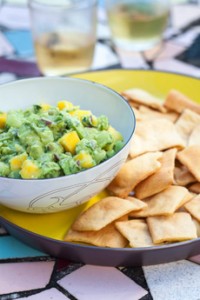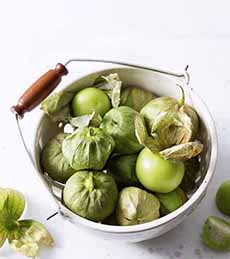Mango-Tomatillo Guacamole Recipe For National Mango Day
|
|
July 22nd is National Mango Day. Add some mango to your guacamole with this Mango-Tomatillo Guacamole recipe. We’ve previously published a recipe for Tomatillo Guacamole, which replaces the red tomatoes in guacamole with green tomatillos. Although they look like green cherry tomatoes, tomatillos are not green tomatoes but are related to the gooseberry. Here”s the difference between tomatoes and tomatillos. Now, we add another ingredient to guacamole: diced mango, which adds bites of sweetness. The recipe is courtesy of Chef Ingrid Hoffmann. The history of mangos is below. For the plural form, both mangos and mangoes are correct. Tortilla chips are a classic pairing, but you can serve this guacamole as a topping or as a side with grilled chicken and fish, as an added layer to sandwiches, burgers, and even hot dogs. Stir some into Greek yogurt for a savory yogurt treat, dip, and sauce. Why Hass avocadoes? There are larger avocados, but the Hass has the creamiest flesh: perfect for guacamole. Here’s more about them. 1. MASH the avocados with a fork in a medium bowl, leaving them still a bit chunky. 2. FOLD in the tomatillos, mango, onion, chile, cilantro, and mint. Add the lemon juice, and gently mix to evenly distribute the ingredients. Season with salt. 3. LAY a piece of plastic wrap directly on the surface of the guacamole to discourage discoloring, and refrigerate until chilled, at least 1 hour. Serve with the chips for dipping. While it may not look like a relative, the mango (Mangifera indica), is a member of the cashew family (Anacardiaceae*). It is one of the most widely cultivated tropical fruits of the tropical world. The mango tree is considered indigenous to southern Asia, especially Myanmar and the Assam state of India, and numerous cultivars have been developed. Mangoes are a rich source of vitamins A, C, and D. The word “mango” came to the English language from the Portuguese manga, from the Malay mangga. Mangoes originated in India more than 4,000 years ago. They spread gradually throughout Asia and then to the rest of the world. Due to the mango’s large center seed, the fruit could not be transported by birds and relied on humans to transport them across the world. Mangos are a sacred fruit in Buddhism. The spread of Buddhism across Southeast Asia resulted in the spread of mangoes. Persians carried mangoes across western Asia and planted seeds in east Africa in the 10th century. The Portuguese disovered the fruit when they came to Kerala in 1498 for the spice trade. The tree was not introduced into the Western Hemisphere until about 1700, when it was planted in Brazil. From Brazil mangoes spread throughout the Americas. They reached the West Indies about 1740 [source]. They were first planted in Barbados in 1742 and by the early 19th century were being grown in Mexico. Mangoes were not really grown in the U.S. until the 1800s. Mango flavor has been described as a mix of oranges, peaches, and pineapples. Today most mangoes found in American grocery stores are grown in Florida, Mexico, Haiti, and South America. However, Asia grows 75% of all mangoes worldwide. India is the top producer [source]. |
|
|
________________ *The Anacardiaceae family also includes tasty foods like the Peruvian pepper, pistachio nuts, and the spice sumac. But it also includes poison ivy and poison oak. Here’s more about it.
|
||



